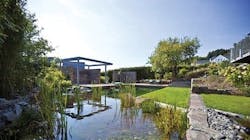Recreational Water Treatment: Swimming With Nature
About the author: Bryn Huntpalmer is editor for Modernize. Huntpalmer can be reached at [email protected].
Many homeowners want to add swimming pools to their outdoor spaces, but have concerns about conventional swimming pools. Some worry about the long-term health consequences of exposure to treatment chemicals such as chlorine. Others do not want to disrupt the natural environment of their backyards, knowing that conventional pools often require removing vegetation and completely altering their backyards.
Natural swimming pools, which have been popular in Europe for years, recently have gained attention in the U.S. Homeowners are attracted to the pools because they can be treated without the use of chemicals and allow for thriving vegetation in backyards.
Building a Natural Swimming Pool
With enough research, homeowners can build their own natural pools, but many hire contractors with experience constructing natural water structures. Natural pools are built using stone, gravel and clay in place of the fiberglass and concrete typically used for conventional pools.
These materials offer environmental benefits. Fiberglass production requires a lot of energy, and concrete production has been linked to the release of carbon emissions. Naturally occurring clay, stone and gravel can be harvested in a responsible way that does not place undue stress on the Earth.
Maintaining Clean Water
Natural pools use unique methods to keep water clean. The pools are split in half, with part of the pool dedicated to swimming and part to vegetation. The latter portion is typically 1 meter or more deep, and the pool water is filtered through the roots of the plants for treatment.
Typically, a pump keeps the water in a natural pool moving. In order to maintain cleanliness, the water must be constantly filtered through the plant roots. The gravel used to construct the pool also plays an important role in water filtration.
While homeowners accustomed to chlorine as a standard of pool water treatment may struggle to adjust to a pool cleaned by non-chemical means, research has shown these pools to be safe.
The Best Plants
Certain plants are better suited for filtering water than others, which is why flag irises or water lilies often are used in natural pools—they are known for keeping phosphate levels at a healthy balance.
In general, three types of plants are needed to maintain clean water. Floating plants, like water lilies, provide shade to underwater vegetation. Other plants are responsible for oxygenating the water. They are important because they absorb nitrates and phosphates, helping maintain balance in the water. Lastly, plants with fibrous roots filter water as it passes through their roots.
Helping a Natural Pool Thrive
Because a natural pool stays clean by natural means, certain factors should be taken into consideration during construction. First, natural pools need to be fairly large, with plenty of surface area for filtration vegetation. They should be no less than 50 sq meters to maintain clean water and avoid algae buildup. The pool must be at least 1 meter deep to protect the living organisms during the coldest winter months.
Natural pools also need plenty of shade. Sunlight is crucial for photosynthesis, but can encourage algae growth. When it comes to natural pools, less sunlight is best to ensure the water is clean and the pool thrives during hot summers.
Pool Maintenance
Maintaining a natural pool requires a different skill set from maintaining a conventional pool. While conventional pools may require the water to be cleaned regularly and tested to ensure safe levels, natural pools typically require the most maintenance at the end of the season.
Before the weather cools, pool owners must prune the plants. They also must remove debris from the water’s surface, and when swimming season is over, cover the pool to avoid further accumulation of debris. It also is important to care for the pump using the manufacturer’s instructions on maintenance and cleaning.
Homeowners who choose natural pools can rest easy knowing they are playing a role in maintaining a healthy environment while protecting their own health.
Download: Here
